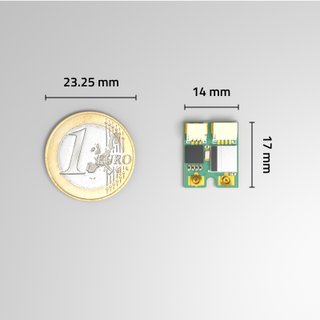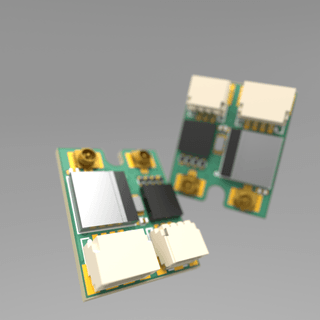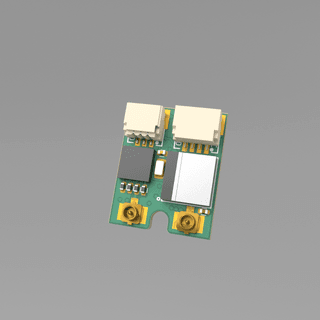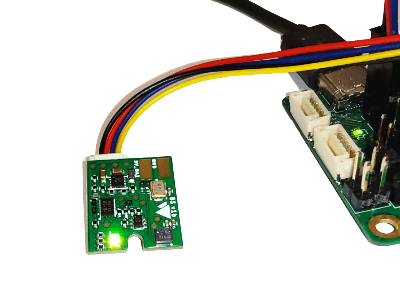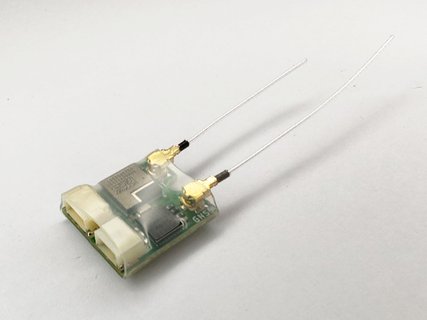Dronetag BS
Tailor-made for aeromodelers & FPV pilots
89 €Get now

Drone RID for FPV, models & hobby planes
Pretty upset about Remote ID requirements for recreational pilots? We get ya. New rules in EU & US regions force Direct / Broadcast Remote Identification (RID) to nearly all pilots. Dronetag BS is here for aeromodelers, FPV pilots and recreational pilots, making their drones compliant without sacrificing limited payload or losing hobby.
Supported regions
European Union
ASD-STANUSA
ASTMWorldwide compliance
Looking for an add-on device without cables, with a built-in battery and with a case?

Bare Minimum for Skilled Drone DIYers
This 1-gram device equips your drone with Bluetooth Direct / Broadcast RID. However, its installation requires external antennas, one for Bluetooth and one for GNSS positioning. Plus, a power source because Dronetag BS comes without any battery. Can you install it on your ultralight FPV drone? Or a custom-built beauty? If yes, go for BS and get compliant in no time! BS is so flexible that you can use it regardless of which drone you use.
If you own DJI or any other branded off-the-shelf drone with sealed-off hardware, the better option for you is Dronetag Beacon. You can easily stick it on the drone without pulling out any wires. Beacon is a fully independent device that comes with a built-in battery, accelerometer, antennas and many other features. What is more, you can quickly swap it between all your drones!
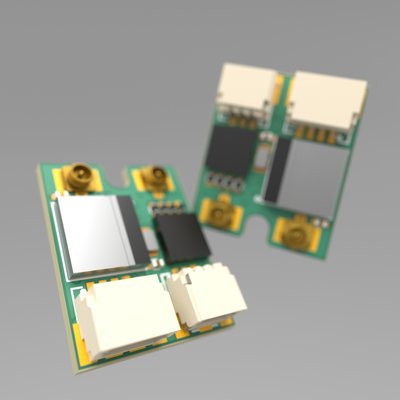
Affordable & Standalone RID Device
Dronetag BS has everything to get you compliant. On your journey to get done with this BS for the least amount of bucks, you might notice we offer an even cheaper RID module. Right? Our DRI Module is a highly specialized component for drone manufacturers that are required to produce Standard Remote ID drones. While BS works as an independent device with its own GPS receiver, the DRI module fully relies on sensor information provided by the flight controller.

All It Takes to Become RID-Compliant
First thing first. Dronetag BS weighs 1.3 grams (0.046 oz), including antennas, so your aircraft should be able to handle this extra payload. Next, you need U.FL compatible antennas, 2.4 GHz for Bluetooth and 1.575 GHz for GNSS. And lastly, power it up with a 3 or 4-pin power input cable (3.3V-17V). Dronetag BS is equipped with flash memory to store a few hours of flight data for later export and a supercapacitor to maintain a GPS fix for 7 minutes in case you need to power-cycle your aircraft.
Looking for Betaflight controller integration? Or operation as a telemetry module for Futaba or Spektrum?
Looking for an out-of-the-box operating RID device that you can easily stick to any drone and swap within your fleet?
Check Dronetag BeaconAvailable on all devices
Dronetag App is a complementary free-to-use app where users can manage their drones and Remote ID devices. It comes with additional features such as airspace zones, flight plans, nearby drone scanning, and notifications about any airspace hazards.
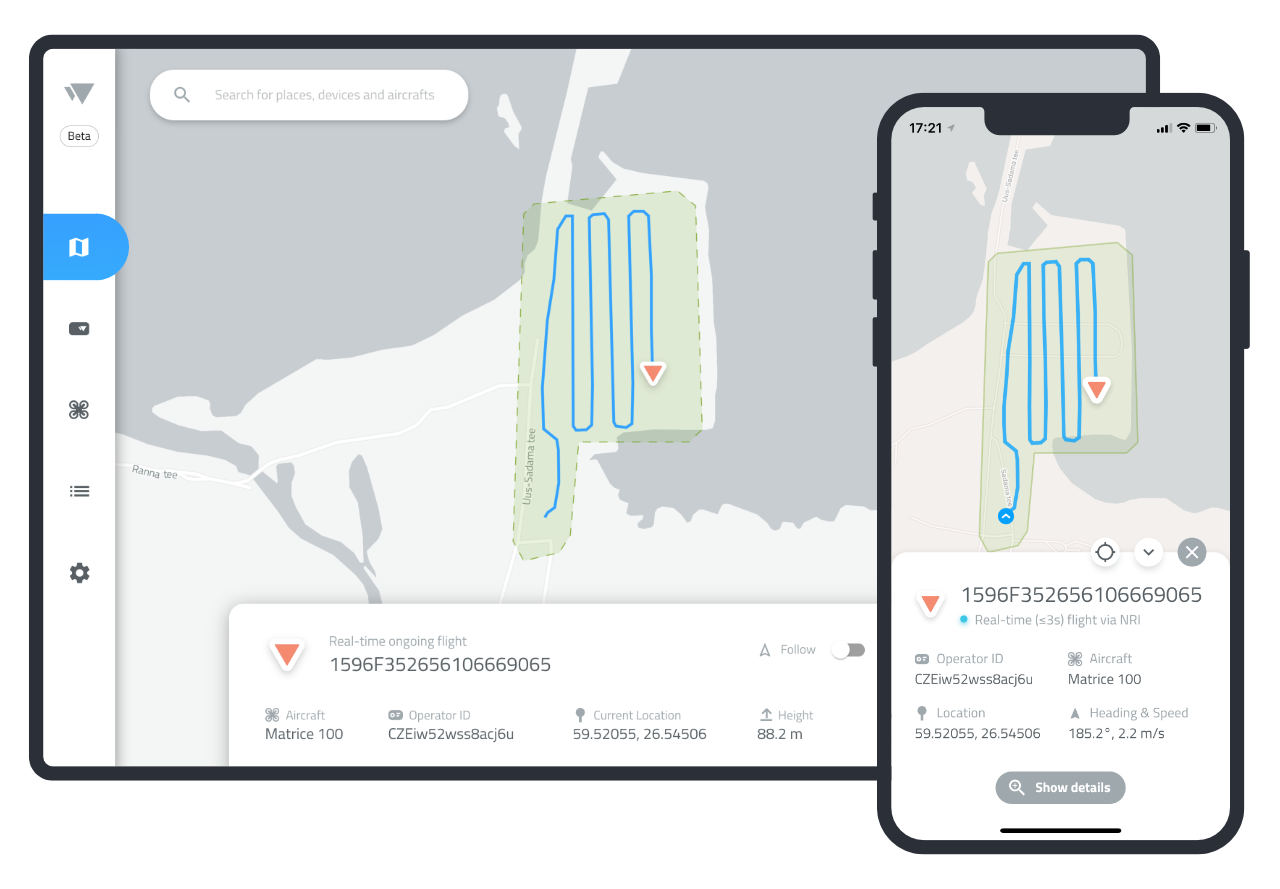
“The number of drone aeromodelers is steadily growing, attacking the 300,000 mark only in the US. Add pilots of lightweight FPV drones all around the world, and it is clear that the drone community needs the RID Basic Solution. The Remote ID is no “BS“. It's the future of drone flying.”
Lukas Brchl, CEO at Dronetag
Features
Flexible Mounting
Dronetag BS is a tiny circuit board that can fit inside the smallest aircraft required to be Remote ID compliant. Use double-sided tape or velcro to mount it in the desired place.Device Management via Mobile App
Forget about disassembling your aircraft to change the settings or update the firmware. Take care of everything in our multiplatform mobile app.External Antennas for Bluetooth and GNSS
Dronetag BS comes with two U.FL connectors for external antennas. The package does include basic Wire antennas. Other types can be bought on our e-shop so you can freely select the proper shape and length.Powered from Aircraft VIN or Battery
BS is designed to operate with power inputs ranging from 3.3V to 17V. The most commonly utilized sources for power input include the flight controller, an aircraft battery or external single-cell LiPo battery.Flash Memory for Flight Data Logging
The device has internal flash memory able to store a few hours of flight data for later export. CSV/KML files can be easily visualized in Dronetag App or, e.g., Google Earth.Supercapacitor for GPS
BS is equipped with supercapacitor to maintain a GPS fix for 7 minutes in case you need to power-cycle your aircraft.ASD-STAN EN 4709-002 & ASTM F3411-22 compliant
Suitable for all regions adopting any of those standards. Broadcast over Bluetooth 4 & 5 to up to 3 km range (distance drone to smartphone). Dronetag BS is Approved by FAA (check the DoC here).Betaflight Controller Integration for GNSS
With the Betaflight controller, use Dronetag BS as GNSS input for telemetry information and GPS rescue. Thanks to an M10 module from u-blox, a state-of-the-art chipset for positioning.Futaba and Spektrum Telemetry Module
Still in development, but soon you can turn Dronetag BS into a telemetry module. With radios Futaba, Spektrum and similar, simply connect the aircraft radio transmitter to the JST connector (3 or 4-pin).
Gallery
Specifications
- Remote ID types
- Direct (EU) / Broadcast (US)
- Short-range radio
- Bluetooth 2.4GHz
- Average current consumption
- 15 mA
- Maximum current consumption
- 50 mA
- Mounting
- Adhesive or velcro
- Operating temperature
- -40°C to +85°C (-40°F to 185°F)
- Dimensions
- 17 x 14 x 5 mm (0.66 x 0.55 x 0.19 in)
- Weight
- 1 gram (0.035 oz) excl. antennas and battery
- Supported baud rates
- Standard ones, configurable in the Dronetag app
- Input voltage
- 3.3 – 17V
- Input voltage regulator
- Low-noise buck converter
- Remote ID Standards
- ASD-STAN EN 4709-002 & ASTM F3411-22
- Certifications
- Uses FCC/CE-approved radio module
- Remote ID technology
- Bluetooth 4.0 Legacy + 5.0 Long Range
FAQ
What is a Remote ID and why do I need it?
Remote Identification (Remote ID), means that other parties can receive basic information about airborne drones digitally (in a similar way to general aviation). The example data that Remote ID drones transmit wirelessly during flight is the operator's registration number, drone serial number, and current position.
Europe and US are currently leading the way with the rest of the world following their trajectory. Remote ID aims to enable organized management of drone operations to ensure safe airspace.
What is the difference between the Direct and Network Remote ID?
There are two types of Remote IDs. The first is Direct (in some countries called Broadcast) Remote ID (DRI), in which the drone broadcasts data directly to nearby entities ranging from hundreds of meters to a few kilometers. The second type is Network Remote ID (NRI), where the drone sends the data via a cellular network to a central system where it can be accessed by other users.
Visit our Knowledge Base for more information.
When do I need DRI and when NRI? Do I need both?
The current European-wide drone regulation requires all drones flying in a Specific category to fulfil the DRI requirements starting 1st July 2022. The technology and protocol are already defined in prEN 4709-002. However, the situation about the NRI mandate is still a bit unclear. All we know is that it will be required to access U-space airspace starting January 2023.
In the USA, the FAA mandates pilots to use DRI modules from September 2023 and drone manufacturers to comply with it (to produce Standard Remote ID drones) starting December 2022.
To sum it up, having both DRI and NRI systems on your drone is better. Dronetag Mini is future-proof and will always fulfill the latest standards.
Why is it not a good idea to use Bluetooth and Wi-Fi RID simultaneously?
Most Remote ID implementations transmitting Bluetooth and Wi-Fi simultaneously don’t implement radio coexistence protocols. This means the radio chip is overwhelmed with transmitting requests despite insufficient radio capacity to send out those data. The result is that the device sends out corrupted data at unreliable frequencies (not fulfilling the requirements in standards) while creating unnecessary electromagnetic noise and interference.
Where is the device manufactured?
All of our devices are manufactured in Prague, Czech Republic, Europe. But the manufacturing site can be changed depending on the customer's needs.
Can I use BS for my FPV drone?
Yes! Dronetag BS is light enough to fit tiny FPV drones that are required to become Remote ID compliant. Most of the FPV pilots can find the right place for Dronetag BS, either inside their drone or outside, using a protective shrink tube for additional protection against elements.
How is BS mounted to my aircraft?
We designed Dronetag BS to fit drones, planes and other aircraft used by aeromodelers. There are many ways to mount tiny circuit boards inside or outside the aircraft body. Use velcro or double-sided tape to attach it to the desired place – simply without any cover or wrapped in the protective shrink tube. This freedom will appreciate owners of the custom-built models.
Is BS approved by FAA?
Yes, you can check the DOC for Dronetag BS here: https://uasdoc.faa.gov/listDocs/RID000000257
Do I need any special tools or knowledge to start using BS?
It is not extremely difficult, yet you should be able to understand the basic principles of your drone hardware and electrical work. Connecting antennas via U.FL connectors is easy, but you also have to use the correct power input with the right voltage. Any mistake can cause permanent damage, so there is not much room for trial-and-error experiments.
Custom-built drone owners might need a little extra work on their drone’s wiring, but as they built the whole drone, there shouldn’t be any problem adding connectors or adjusting voltage, right? If you have any doubts, feel free to ask for help on our contact page.
What is the difference between DRI and BS?
The main difference between BS and DRI is the ability to work as a standalone system. Dronetag BS has everything needed to get you Remote ID compliant, which includes an internal GNSS receiver. On the other hand, Dronetag DRI is mainly an OEM product for integrators and manufacturers that relies on sensor information provided by the flight controller. If you need a self-contained & standalone system, go with Dronetag BS. If you need Standard Remote ID implementation in the US or plan to produce C-class drones as defined in the EU, we suggest Dronetag DRI.
Can I use BS on my DJI, Parrot or Autel drone?
If you are looking for a solution for your DJI or other off-the-shelf drones, we strongly recommend purchasing an out-of-the-box operating device Dronetag Beacon. It is the best solution for sealed-off drones and can be easily moved from one aircraft to another. Basic solution Dronetag BS is a solution designed for hobbyists and DIYers – it has no hard case and needs external battery + two antennas (GPS + Bluetooth). Its installation is for those who have experience with electrician work and know their drones offer sufficient hardware options.
Using Dronetag BS on DJI drones is at your own risk, and we do not provide any support.
Why should I select your Remote ID solution rather than others?
Our company started developing drone coordination systems in 2018, even before they were called Remote ID. We focused on finding additional value in such systems from the very early beginning rather than just solving the regulatory burden. Our strategy is customer-oriented, so we try to make all our systems and relevant documentation as easy as possible. We stand behind the excellent user experience of our solution, and to prove that fact, we were the first company involved in unsponsored public reviews on the Remote ID topic. Some significant stakeholders, such as Air Navigation Services, drone manufacturers, and UTM providers, have also shown trust in our company. See them in Partners.
Why Dronetag BS uses Bluetooth instead of Wi-Fi for Remote ID?
From our perspective, there are 3 main reasons why Bluetooth is better than Wi-Fi for Remote ID:
-
Wi-Fi RID add-on devices often interfere with the drone's radio control as they operate on the same bands. Meanwhile, Bluetooth uses so-called beacon channels separated from the most common drone frequencies. Check the image below to see how it works.
-
Wi-Fi RID needs more transmission power. ASD-STAN and ASTM standards require the maximum possible power for your RID transmitter, Wi-Fi or Bluetooth. All Wi-Fi transmitters can usually do up to 20 dBm (100 mW), which is ten times more than the Bluetooth alternative. Wi-Fi not only consumes a lot of battery power but creates electromagnetic interference that can influence the internal sensors of the drone, such as GNSS or compass. On the other hand, Bluetooth is usually limited to 10 dBm (10 mW), making it a way more efficient choice.
-
Almost all common smartphones are unable to receive Wi-Fi signals frequently. Please see our video explanation of why smartphones don’t like Wi-Fi-based RID.
-
